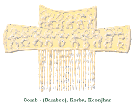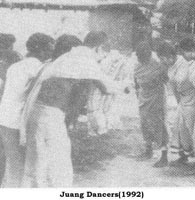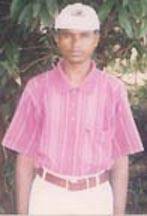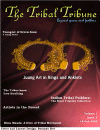Artist in the Forest
|
The Juang (also spelt as Juanga) is a tribal community living in the hills and forest covered plains of central Orissa (in Eastern part of India). The word Juanga means "human being" or "man." The Juanga woman is called "Juangadai". They are thin built, short stature, brown complexion people speaking a language of Mundari group confirming to Australoid racial category. They were mentioned by E. T. Dalton in “Descriptive Ethnology of Bengal”(1872). The well known missionary turned anthropologist Verrier Elwin was attracted to these forest living artistic people in the mid-forties of the last century. The Junags were studied by various scholars at different times on various aspects of their existence viz., social, cultural, economy, ecological, physical and health.
|
 |
|
 |
These scantily clad forest dwellers, were never short of decorative ideas and capacities. Their houses are very simple but these people know how to design decorative ornaments, artifacts and even bamboo flutes and combs. In a convenient spacious location they build an open door "Majanga" or "Manda Ghara," a community house, where they gather in the morning to decide on community tasks. The pictures presented here from late nineteenth century celluloid capture by Dalton in mid twentieth century and photograph by Elwin have become historical past. With passage of time and change in cultural outlook due to exposure to the development agents, the Juangs have learnt to cover their bodies with modern garments like other Hindu neighbours. Their own language has been confined to themselves and they communicate with others in Oriya language.
The whole tribal community lives in two adjacent districts viz., Keonjhar and Dhenkanal in central Orissa. It is claimed that they originally lived in the hills of Keonjhar near the origin of a major river Baitarani (Juang pirh – tr. seat of Juang). The numerical strength of the Juangs constantly increased from 9173 in 1891 census to 30,876 in 1981 census, with slight decrease in 1921 and 1951 census counts. These people originally used to cultivate Hill Land (Taila) by slash and burn cultivation (Dahi). The Dhenkanal Juangs started cultivating low land and became settled cultivators. Shrinking land on the hills and Government prohibitions, could not sustain growing population since 1961. Now many Juangs accepted wage labour as primary means of earning. In spite of poverty, these forest dwellers are very fond of dance, decorative art and merry making. Some examples of Juang art is presented here from collection of Verrier Elwin (The Tribal Art of Middle India) and Shri A. C. Sahoo (Art and Culture of the Juang). The article of Dr. Rabi Narayan Dash, in this issue, is an exclusive exposition of Juang ornaments. This issue carries a Juang story from The Biyot Tripathy Collection made by Dr. Biyotkesh Tripathy who is engaged in collection of Indian tribal folklore comprising myths, legends, tales, songs and lore. |
 |
|
|||||||||||||||
Sources: Photographs
-
Comb: The Tribal Art of Middle India by Verrier Elwin
-
Flute: A. C. Sahoo
-
Juang Girls(1872): Descriptive Ethnology of Bengal by E. T. Dalton
-
Juang Girl (1948): Man In India by Verrier Elwin
-
Juang Dancers (1992): Juang Dance by R. P. Prusty
-
First Graduate: Dr. Biyotkesh Tripathy
(1 to 5 are taken from the book Art and Culture of Juang, Ed. by Dr. Rabi Narayan Dash, Published by Orissa Lalit Kala Academy, 1992)







